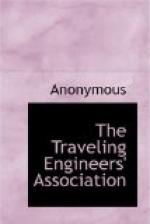A. Yes. At least every ten miles.
45. Q. Do you know that the engine should be working hard and at a speed not less than twenty miles per hour when sanding flues to avoid the sand falling to floor of the fire-box and accumulating in front of them?
A. Yes.
46. Q. Do you realize that on first closing throttle you should not adjust fire too low? Explain best method.
A. Yes. I would allow steam pressure to fall back some fifteen pounds before throttle is closed and on having closed same leave a good fire in box, allowing it to cool gradually to avoid leaky flues, broken staybolts, cracked sheets caused by sudden fall of temperature.
47. Q. How is the flow of oil controlled?
A. By the valves in tank and pipe connections.
48. Q. Name these valves, their location and purpose.
A. The safety valve controls the flow of oil from the fuel oil tank through an opening in bottom sheet of tank to the pipes leading to burner. This valve is forced to its seat by a heavy spring and is held off its seat by a key in the upright rod extending above the top of tank. To this key a rope or chain is attached and also attached to the cab to cause the pin in rod to be pulled in case of a separation between engine and tank and allow the valve to be seated by its spring and avoid a waste of oil. The second or main oil valve is located in oil pipe under deck leading to burner. It is usually of the plug-cock pattern connected by bell crank and this connected to some part of the engine by chain, in which case it also acts as a safety valve in case of separation between engine and tender. In other cases it is connected by an operating rod extending above deck of tender where it can be operated by hand in case of safety valves failure to shut off the flow of oil. The third or firing valve is usually located between heater box and burner, and is provided with an upright rod extending into cab where it is provided with a handle or lever in position to be conveniently handled by fireman while seated in cab. This valve regulates the flow of oil desired to reach the fire.
49. Q. When shutting out fire which valve should be closed first? Why?
A. The safety valve. To allow the oil in pipes to be consumed and to see that this valve is in working order.
50. Q. Should safety valve fail to shut off the flow of oil in such cases would it be safe to rely on the firing valve to shut off the fire?
A. No. The main valve should then be closed.
51. Q. Should the firing valve be depended upon to shut off the fire at any time? Why?
A. No. From constant use they are frequently leaking and the trouble is not detected while in use, and again there is always danger of the handle being moved by workmen or others about the cab.
52. Q. What is a heater box?
A. It is an apparatus having two passages, one for steam passing from boiler to heater pipes in tank and another passage for oil from tank before it is delivered to burner. In this manner the oil before reaching the burner is heated much higher than the temperature of that contained in tank.




